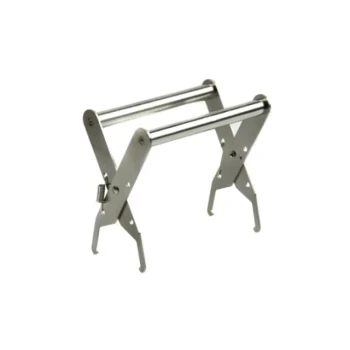At its core, a hive tool is a specialized pry bar for beekeepers. The primary types are the standard hive tool, which excels at prying and scraping, and the J-hook hive tool, which adds a unique hook for easily lifting frames. Other variations, like multifunction scrapers, build upon these basic designs for more specialized tasks.
The essential choice is not about finding a single "best" tool, but understanding the trade-off between the simple, brute-force prying of a standard tool and the gentle, leveraged frame-lifting capability of a J-hook tool.

Why a Specialized Hive Tool is Essential
Bees use a sticky, resinous substance called propolis to seal every crack and seam inside their hive, essentially gluing the boxes and frames together. A specialized hive tool is designed to break this powerful seal without damaging the wooden components of the hive or jarring the bees unnecessarily.
The Problem with Alternatives
While a screwdriver or small pry bar can be used in an emergency, they are poor substitutes. These tools lack the wide, flat edges needed for effective scraping and can easily damage the soft wood of hive bodies and frames, creating openings for pests and reducing the lifespan of your equipment.
The Core Hive Tool Designs
Each hive tool is designed around a few key functions: prying, scraping, and lifting. The differences in their design determine how well they perform each task.
The Standard Hive Tool (The Classic)
This is the simplest and often most durable design. It typically features a flat, wide end for scraping and a bent or hooked end for prying.
Its primary strength is prying apart stubborn hive bodies. The solid steel construction makes it an indestructible workhorse for tasks that require significant force.
The J-Hook Hive Tool (The Frame Lifter)
The J-hook tool has a standard flat scraper on one end and a distinctive "J" shape on the other. This is its key advantage.
The hook is designed to rest on the frame rest of the hive box, allowing you to use leverage to gently pry up and lift the first frame. This is much less jarring to the bees and reduces the risk of rolling or crushing them, which can happen when trying to pry frames with a standard tool.
The Multifunction Scraper
These tools combine features of the standard and J-hook designs while adding others, such as a sharp edge for cutting burr comb, a nail puller, or a small hammer face.
While versatile, they can sometimes be a master of none. The added features can occasionally get in the way of the core prying and scraping tasks.
Understanding the Trade-offs
Choosing a tool requires understanding what you gain and what you give up with each design.
Strength vs. Finesse
The standard tool offers maximum strength for prying apart heavily propolized boxes. However, it lacks the finesse for delicate work like lifting individual frames.
The J-hook excels at the delicate task of frame removal but may not feel as robust as a standard tool for extremely heavy-duty prying.
Simplicity vs. Versatility
A simple standard or J-hook tool does its core job exceptionally well. A multifunction tool offers more options but can be more cumbersome for basic tasks. For most beekeepers, a dedicated J-hook or standard tool is more effective.
Making the Right Choice for Your Needs
Your choice should be guided by your priorities during a hive inspection.
- If you are a new beekeeper and can only buy one tool: The J-hook is the most recommended starting point because its frame-lifting ability makes inspections significantly easier and gentler.
- If your primary focus is heavy-duty work and separating boxes: The classic standard hive tool is an indestructible and reliable choice.
- If you want to minimize disturbance to your bees: The J-hook's lever action for lifting frames is superior to any other method.
- If you already own a primary tool and want a backup: A multifunction scraper can be a useful addition to your toolkit for handling odd jobs.
Ultimately, the right hive tool is the one that makes your inspections smoother, safer for the bees, and less damaging to your equipment.
Summary Table:
| Tool Type | Primary Use | Key Advantage |
|---|---|---|
| Standard Hive Tool | Prying apart hive bodies, scraping propolis | Maximum strength and durability for heavy-duty prying |
| J-Hook Hive Tool | Gently lifting frames, scraping | Leveraged hook for easy, bee-friendly frame removal |
| Multifunction Scraper | Versatile tasks (scraping, cutting comb, etc.) | Combines multiple features in one tool |
Equip your commercial apiary or distribution business with the right tools for the job. HONESTBEE supplies durable, professional-grade hive tools in bulk to meet the demands of large-scale beekeeping operations. Let our wholesale-focused expertise help you streamline your equipment supply. Contact our team today to discuss your needs and request a catalog!
Visual Guide

Related Products
- Professional Stainless Steel Pry-Bar Hive Tool
- HONESTBEE Advanced Ergonomic Stainless Steel Hive Tool for Beekeeping
- HONESTBEE Classic Pry Bar Hive Tool with High Visibility Finish for Beekeeping
- HONESTBEE Professional Long Handled Hive Tool with Precision Cutting Blade
- HONESTBEE Premium Italian Style Hive Tool with Hardwood Handle
People Also Ask
- What types of hive tools are available for beekeepers? Choose the Right Lever for Your Apiary
- What is the correct method for lifting frames with a hive tool? Master the Technique for a Calm Hive
- What are the parts of a hive tool? Master Your Hive Inspections with the Right Tool
- What additional safety equipment should beekeepers use? Essential Tools for Hive Management
- What equipment and implements are needed by beekeepers besides the hives? Build Your Essential Beekeeping Toolkit



















